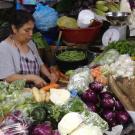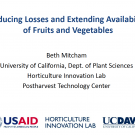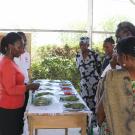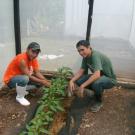After harvest, fruits and vegetables need to be handled with care to maintain freshness, nutrient content, taste and quality. Fruits and vegetables are highly perishable, and so poor after harvest handling can result in losses. The field of postharvest practices addresses issues of handling, transportation and temperature control for crops after harvest. Good postharvest handlng is critical to reducing postharvest losses of fresh produce, to maintain quality, preserve nutrient content, and earn higher prices at market.
Horticulture Innovation Lab researchers test the efficacy of postharvest technologies and build capacity among local leaders in postharvest practices. Below are fact sheets, videos, manuals, and other training materials for improving postharvest practices with horticultural crops.






